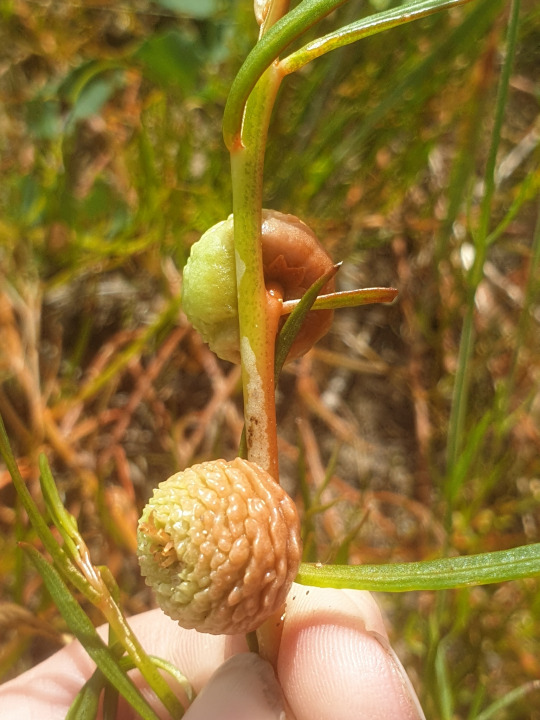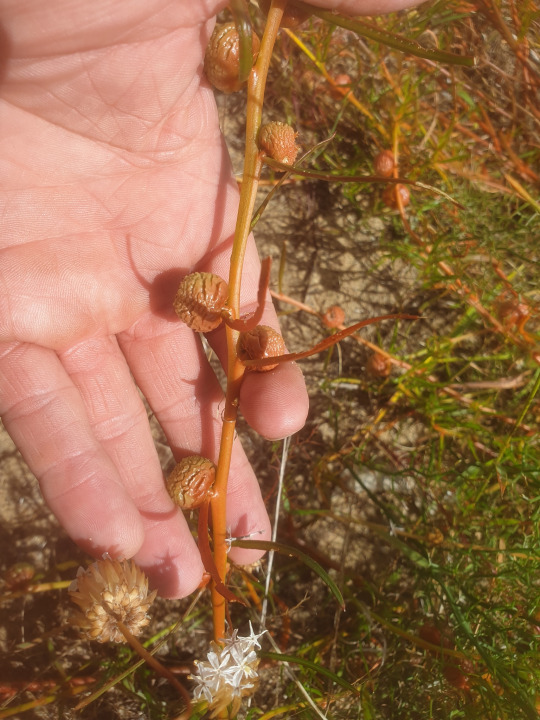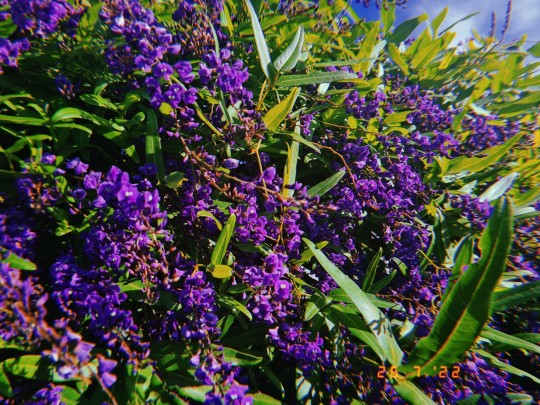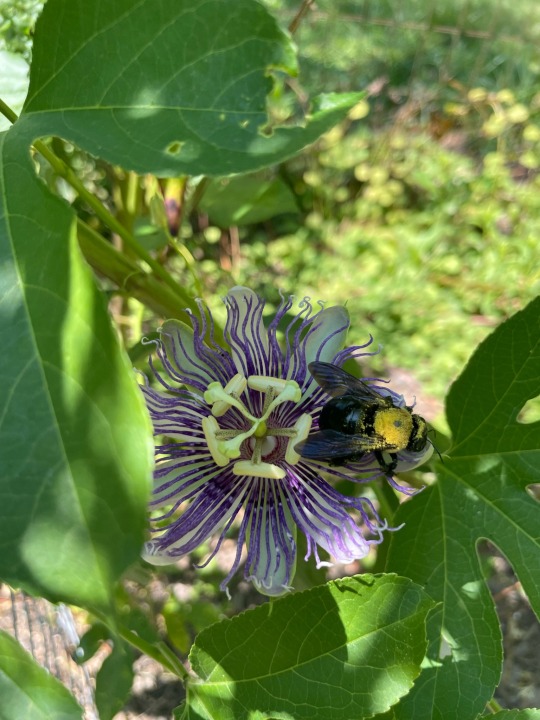#native plant
Photo



Cornus canadensis (Canadian bunchberry)
About a month ago I was talking to a neighbor about her pink dogwood tree and she showed me a four petaled, white flower in her garden. She said it had just “shown up” last year and wondered if this was a dogwood too. “Oh no,” I said, “dogwoods are either shrubs or small trees. I’ve never seen a dogwood growing as a groundcover before.”
Of course this conversation raised an element of doubt and as soon as I got home I opened my copy of Plants of Coastal British Columbia (revised edition) and there it was on page 320, Cornus canadensis. A week later I was walking the forest trails in Stanley Park and I found it all over the place.
This wildflower is native to Canada, Greenland, Northern China, North Korea, Japan, parts of Siberia and a number of US states. Although most dogwoods are shrubs and small trees, two species, Canadian bunchberry and Alaskan bunchberry (Cornus × unalaschkensis) grow between four and eight inches tall.
#flowers#photographers on tumblr#Canadian bunchberry#dogwood#native plant#fleurs#flores#fiori#blumen#bloemen#Stanley Park#Vancouver
86 notes
·
View notes
Text
Intersection After a Rain

View On WordPress
7 notes
·
View notes
Photo

I have refused to live
locked in the orderly house of
reasons and proofs.
The world I live in and believe in
is wider than that. And anyway,
what’s wrong with Maybe?
You wouldn’t believe what once or
twice I have seen. I’ll just
tell you this:
only if there are angels in your head will you
ever, possibly, see one.
~ Mary Oliver
107 notes
·
View notes
Text
The VERY Hungry Caterpillar 🐛


#mother nature#caterpillar#monarch caterpillars#monarch butterfly#milkweed#native plant#happy#nom nom
2 notes
·
View notes
Text
So many honey bees on my mountain mint.
3 notes
·
View notes
Text
Oregon grape - beautiful no matter the season

10 notes
·
View notes
Text
#1868 - Tersonia cyathiflora - Button Creeper


Named by French botanist Alfred Moquin-Tandon in honour of his wife Joséphine Louise Moquin-Tandon, nee de Terson, and ‘fleshy leaves’. The petals on the flowers are disturbingly fleshy and tentacle-like too (the white things in the second photo are an unrelated plant).
Tersonia has two species, both WA endemics, and both are obligate fire ephemerals - the seeds won’t germinate without exposure to smoke. From the limestone heath south of Yanchep NP, north of Perth. Sand over limestone is the only place it will grow - so it’s quite common along the coast here in Perth, at least where we’ve had recent fires.
Their family, the Gyrostemonaceae, is on the small side too - 4 genera, and about 20 known species. All are small wind-pollinated shrubs or trees, endemic to temperate parts of Australia.
2 notes
·
View notes
Text


Hardenbergia
#garden#plants#purple#hardenbergia#native plant#flowercore#naturecore#Australian#australian native#gardeners on tumblr#my photography
5 notes
·
View notes
Text
#tiktok#andrew_the_arborist#urban gardening#urban landscape#ecofriendly#native wildflowers#eco friendly#eco lawn#native plants#garden#gardening
27K notes
·
View notes
Text

Calochortus leichtlinii
Smokey mariposa, Leichtin's Mariposa
Native to coniferous forests and chaparral habitat including lowest elevation grassy hills in the Sierra Nevada mountains, California, USA
Estimate plant range from California Native Plant Society:

0 notes
Text
"With “green corridors” that mimic the natural forest, the Colombian city is driving down temperatures — and could become five degrees cooler over the next few decades.
In the face of a rapidly heating planet, the City of Eternal Spring — nicknamed so thanks to its year-round temperate climate — has found a way to keep its cool.
Previously, Medellín had undergone years of rapid urban expansion, which led to a severe urban heat island effect — raising temperatures in the city to significantly higher than in the surrounding suburban and rural areas. Roads and other concrete infrastructure absorb and maintain the sun’s heat for much longer than green infrastructure.
“Medellín grew at the expense of green spaces and vegetation,” says Pilar Vargas, a forest engineer working for City Hall. “We built and built and built. There wasn’t a lot of thought about the impact on the climate. It became obvious that had to change.”
Efforts began in 2016 under Medellín’s then mayor, Federico Gutiérrez (who, after completing one term in 2019, was re-elected at the end of 2023). The city launched a new approach to its urban development — one that focused on people and plants.
The $16.3 million initiative led to the creation of 30 Green Corridors along the city’s roads and waterways, improving or producing more than 70 hectares of green space, which includes 20 kilometers of shaded routes with cycle lanes and pedestrian paths.
These plant and tree-filled spaces — which connect all sorts of green areas such as the curb strips, squares, parks, vertical gardens, sidewalks, and even some of the seven hills that surround the city — produce fresh, cooling air in the face of urban heat. The corridors are also designed to mimic a natural forest with levels of low, medium and high plants, including native and tropical plants, bamboo grasses and palm trees.
Heat-trapping infrastructure like metro stations and bridges has also been greened as part of the project and government buildings have been adorned with green roofs and vertical gardens to beat the heat. The first of those was installed at Medellín’s City Hall, where nearly 100,000 plants and 12 species span the 1,810 square meter surface.
“It’s like urban acupuncture,” says Paula Zapata, advisor for Medellín at C40 Cities, a global network of about 100 of the world’s leading mayors. “The city is making these small interventions that together act to make a big impact.”
At the launch of the project, 120,000 individual plants and 12,500 trees were added to roads and parks across the city. By 2021, the figure had reached 2.5 million plants and 880,000 trees. Each has been carefully chosen to maximize their impact.
“The technical team thought a lot about the species used. They selected endemic ones that have a functional use,” explains Zapata.
The 72 species of plants and trees selected provide food for wildlife, help biodiversity to spread and fight air pollution. A study, for example, identified Mangifera indica as the best among six plant species found in Medellín at absorbing PM2.5 pollution — particulate matter that can cause asthma, bronchitis and heart disease — and surviving in polluted areas due to its “biochemical and biological mechanisms.”
And the urban planting continues to this day.
The groundwork is carried out by 150 citizen-gardeners like Pineda, who come from disadvantaged and minority backgrounds, with the support of 15 specialized forest engineers. Pineda is now the leader of a team of seven other gardeners who attend to corridors all across the city, shifting depending on the current priorities...
“I’m completely in favor of the corridors,” says [Victoria Perez, another citizen-gardener], who grew up in a poor suburb in the city of 2.5 million people. “It really improves the quality of life here.”
Wilmar Jesus, a 48-year-old Afro-Colombian farmer on his first day of the job, is pleased about the project’s possibilities for his own future. “I want to learn more and become better,” he says. “This gives me the opportunity to advance myself.”
The project’s wider impacts are like a breath of fresh air. Medellín’s temperatures fell by 2°C in the first three years of the program, and officials expect a further decrease of 4 to 5C over the next few decades, even taking into account climate change. In turn, City Hall says this will minimize the need for energy-intensive air conditioning...
In addition, the project has had a significant impact on air pollution. Between 2016 and 2019, the level of PM2.5 fell significantly, and in turn the city’s morbidity rate from acute respiratory infections decreased from 159.8 to 95.3 per 1,000 people [Note: That means the city's rate of people getting sick with lung/throat/respiratory infections.]
There’s also been a 34.6 percent rise in cycling in the city, likely due to the new bike paths built for the project, and biodiversity studies show that wildlife is coming back — one sample of five Green Corridors identified 30 different species of butterfly.
Other cities are already taking note. Bogotá and Barranquilla have adopted similar plans, among other Colombian cities, and last year São Paulo, Brazil, the largest city in South America, began expanding its corridors after launching them in 2022.
“For sure, Green Corridors could work in many other places,” says Zapata."
-via Reasons to Be Cheerful, March 4, 2024
#colombia#brazil#urban#urban landscape#urban planning#cities#civil engineering#green architecture#green spaces#urban heat#urban heat island effect#weather#meteorology#global warming#climate change#climate hope#climate optimism#climate emergency#climate action#environment#environmental news#city architecture#bicycling#native plants#biodiversity#good news#hope#solarpunk#ecopunk#hopepunk
12K notes
·
View notes
Text
The Use of Native Plants in Florida Ecosystem Restoration

Florida is home to diverse ecosystems, from pristine beaches to lush forests and wetlands. However, the rapid urbanization and development of this beautiful state have significantly impacted its natural landscapes. Ecosystem restoration has become crucial in preserving Florida's unique biodiversity and ensuring the health of its environment. One key element in this restoration process is the use of native plants, which play a vital role in recreating and maintaining the balance of these ecosystems.
Native Plants: The Building Blocks of Restoration
Why Native Plants Matter
Native plants are species that have evolved and adapted to the specific environmental conditions of a region over thousands of years. In Florida, these plants are not only a part of the natural landscape but also essential to its ecological health. They have adapted to the local climate, soil, and wildlife, forming complex relationships with other native species. Using non-native or invasive plants can disrupt these delicate balances and harm the ecosystem.
Benefits of Native Plants in Restoration
Biodiversity Preservation: Native plants support native wildlife, from insects to birds and mammals. Using native species in restoration efforts helps maintain biodiversity by providing food, shelter, and breeding grounds for these creatures.
Erosion Control: Native plant roots are well-suited to Florida's soils, preventing erosion and protecting water quality. They stabilize the soil, reducing the risk of stormwater runoff.
Drought Resistance: Florida's climate can be challenging, with periods of drought. Native plants are adapted to these conditions, reducing the need for excessive watering and maintenance.
Low Maintenance: Landscaping services that use native plants can enjoy reduced maintenance costs and effort. These plants have evolved to thrive locally with minimal human intervention.
Landscaping Services and Native Plant Restoration
Landscaping services in Florida play a vital role in ecosystem restoration by promoting the use of native plants. They can provide expert knowledge in selecting the right species for a specific location and ensuring proper planting and care. When homeowners and businesses incorporate native plants into their landscapes, they contribute to the restoration of natural ecosystems.
Restoring Florida's ecosystems is an ongoing effort that requires the active involvement of professionals and individuals. Native plants are essential components in this restoration process, offering numerous environmental benefits. With their expertise and knowledge, Landscaping services can guide and encourage the use of native plants, significantly impacting the health and beauty of Florida's natural landscapes. By choosing native plants, we can all contribute to preserving Florida's unique ecosystems for future generations.
Down To Earth Landscape & Irrigation
2701 Maitland Center PKWY, Suite 200,
Maitland, FL 32751
321-263-2700
0 notes
Text
Early Spring, Plant Check-in
Enjoy my catching up with landscape, garden, and wild foothills visits from months ago.

View On WordPress
#Albuquerque#Chihuahuan Desert#desert#design#hike#home garden#landscape#native plant#residential#xeriscape
1 note
·
View note
Text

2023_01_14
#january#nz#mason bay#rakiura#stewart island#dunes#sand dunes#Gunnera#native plant#Gunnera hamiltonii
1 note
·
View note
Text
From Seed to Sight: A Comprehensive Guide to Growing and Propagating Asclepias Tuberosa for a Lively Butterfly Garden
Brief Overview of Asclepias tuberosa (Butterfly Weed)
Asclepias tuberosa, commonly known as butterfly weed, is a captivating, brightly colored perennial plant native to North America. It is a member of the milkweed family, Apocynaceae, and it thrives in a wide range of environments, from open prairies to roadsides. The plant is renowned for its vibrant orange-to-yellow flowers that cluster at…

View On WordPress
#Asclepias tuberosa (Butterfly Weed)#attract butterflies#butterflies#butterfly#butterfly garden#drought-tolerant#larval food source#native plant#nectar plant#orange#perennial#yellow
0 notes
Text


Maypop (aka passionflower) and it’s fruit. It’s wild how much pollen these flowers leave on the bees that visit them.
2 notes
·
View notes